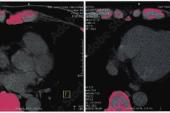High-Risk ‘Clues’ Add Heft to Calcium Scores in Primary Prevention
Severe calcium in the left main, along with diabetes, identified patients with risks higher than those with established ASCVD.

Not all patients with very high levels of coronary artery calcium (CAC) are created equal when it comes to cardiovascular risk, with new research providing some clues on how to identify a particularly high-risk patient who could benefit from aggressive primary prevention strategies.
Among asymptomatic patients with a CAC score > 1,000, those who have severe calcium in the left main coronary artery and diabetes have more than a sevenfold higher risk of death of atherosclerotic cardiovascular disease (ASCVD) compared with those who just have a high CAC score alone, report investigators.
“In patients that already have very high calcium scores, there are additional markers that can give us clues into the heterogeneity within this high-risk group,” lead investigator Alexander Razavi, MD, PhD (Emory University School of Medicine, Atlanta, GA), told TCTMD.
Homing in on those with severe calcification in the left main and diabetes is important because these patients have risks on par with some secondary-prevention patients, he added. “If we are comparing the crude rates of ASCVD mortality and all-cause mortality, they correspond with rates that have been previously found for patients that have already had an event and are also defined as very high risk,” said Razavi.
Research has shown primary-prevention patients with a CAC score > 1,000 have annualized rates of ASCVD and all-cause mortality that are equivalent to those of stable, well-treated secondary-prevention patients, said Razavi. Given this excess risk, an expert consensus from the American College of Cardiology recommended such patients be treated to an LDL-cholesterol target of less than 70 mg/dL (or an LDL level reduced by 50% or more) with high-intensity statins and other nonstatin therapies, if needed.
“Along those lines, is there a subset of these patients that are perhaps very high risk?” said Razavi, explaining the rationale for the present study. Traditionally, the high-risk patient has been defined as someone who already had a clinical event and was at risk of having another, and while that cardiac history remains an important guide to treatment, “I think over the past few years, our paradigm to treatment and initiating high-intensity combination therapy has evolved to where it's a spectrum of risk that tracks along atherosclerotic plaque burden,” he said.
In patients that already have very high calcium scores, there are additional markers that can give us clues into the heterogeneity within this high-risk group. Alexander Razavi
Matthew J. Budoff, MD (Harbor-UCLA Medical Center, Los Angeles, CA), said teasing out a greater understanding of the location or distribution of coronary calcification is emerging as an important identifier of higher-risk primary-prevention patients, but that it’s not currently done in clinical practice given lack of evidence supporting the concept to date.
“I think [this study] does show very nicely that a lot of calcification built up in the left main is important,” Budoff told TCTMD.
In 2023, Budoff published data showing that patients with CAC scores > 300 had risk of major adverse cardiovascular events similar to those with established ASCVD. With the higher CAC threshold, in addition to severe calcification in the left main and/or diabetes, patients in the present analysis more closely mirror those in FOURIER, the cardiovascular outcomes trial testing evolocumab (Repatha; Amgen) in a very-high-risk patient population (ASCVD diagnosis plus one major cardiovascular risk factor or two minor risk factors), he said.
Treating Before Event, Not After
For the study, which was published last week in JACC: Cardiovascular Imaging, the researchers wanted to identify risk factors associated with increased ASCVD mortality in patients with very high CAC scores. To do so, they turned to data on 2,246 asymptomatic patients (average age 66.6 years; 14% female) included in the CAC Consortium, a national, retrospective cohort study from four academic medical centers in the US. The median 10-year risk of ASCVD was 16.7%, and the median CAC score was 1,592. Over 11.3 years of follow-up, 8.0% of patients died from ASCVD.
In a multivariable model, age and diabetes were both associated with mortality: diabetes was tied to twofold and 2.5-fold higher risks of death from ASCVD and coronary heart disease causes, respectively.
Independent of traditional risk factors, there was a dose-response relationship between CAC burden in the left main artery and ASCVD, CHD, and all-cause mortality. A CAC score of 300 or more in the left main was associated with significantly higher risks of ASCVD mortality (HR 2.32; 95% CI 1.51-3.55), CHD mortality (HR 2.96; 95% CI 1.77-4.92), and all-cause mortality (HR 1.81; 95% CI 1.33-2.46). When assessed as percentage of calcification in the left main, higher CAC burden was also associated with increased mortality.
The overall event rates for ASCVD, CHD, and all-cause mortality was 0.8. 0.5, and 2.0 per 100 person-years, respectively. Comparatively, for those with diabetes or a left main CAC score ≥ 300, the ASCVD mortality event rates were 1.4 and 1.3 per 100 person-years, respectively, which are on par with secondary-prevention patients who’d be considered to be at very high risk, say investigators. For patients with both diabetes and a left main CAC score ≥ 300, the ASCVD mortality rate per 100 person-years was 7.1, which is more than fivefold higher than crude rates previously reported for very-high-risk secondary-prevention patients.
If we can identify these high-risk individuals who have not yet had a first event and get them on proper therapy, hopefully we can do a lot of good. Matthew J. Budoff
In symptomatic patients, Razavi said there are data showing that patients with significant left main coronary artery disease do have better mid-term survival with CABG surgery compared with medical therapy alone.
“One of the unique features of this study is that these are all patients without chest pain who happen to have a very high calcium score,” said Razavi. In terms of whether such patients—those with a very high CAC score and significant burden of calcification in the left main—would benefit from an intervention over medical therapy remains an open question, he said.
“But I think we should be cautious because we don’t want a calcium score to lead to unnecessary downstream testing if the patient is asymptomatic,” said Razavi. “There's no indication to pursue a coronary cath or an intervention. We're really focusing on aggressive risk factor control.”
Like Razavi, Budoff said that identifying a higher-risk primary-prevention patient is important for aggressive risk factor control, noting that while there are drugs like ezetimibe, PCSK9 inhibitors, and even inclisiran (Leqvio; Novartis) to lower LDL-cholesterol levels in addition to high-intensity statins, there also are certain medications, such as glucagon-like peptide 1 agonists or icosapent ethyl (Vascepa; Amarin), that aren’t.
“There’s a lot of drugs that are segmented for secondary prevention only, and not really accepted in primary prevention algorithms,” Budoff told TCTMD. “But I always tell people, you don't want to say, if you survive that first heart attack, then I'm going to put you on a PCSK9 inhibitor. That's not where we want to be with our medication. If we can identify these high-risk individuals who have not yet had a first event and get them on proper therapy, hopefully we can do a lot of good.”
Michael O’Riordan is the Managing Editor for TCTMD. He completed his undergraduate degrees at Queen’s University in Kingston, ON, and…
Read Full BioSources
Razavi AC, Shaw LJ, Berman, et al. Left main coronary artery calcium and diabetes confer very-high-risk equivalence in coronary artery calcium > 1,000. J Am Coll Cardiol Img. 2024;Epub ahead of print.
Disclosures
- Razavi reports no conflicts of interest.
- Budoff reports grant support from the National Institutes of Health and General Electric.





Comments